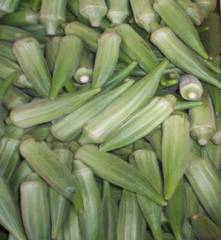Special Feature: Products Sally Recommends
Okra: Why Eat the Vegetable Formally Known as Hibiscus Esculentus
 This vegetable also known as Okra, Ochro, Okro, Bhindi, Bamia, Bamieh, Gumbo, quimgumbo and even Lady Fingers, is one of our planets most nutritious and mouth-watering vegetables.
This vegetable also known as Okra, Ochro, Okro, Bhindi, Bamia, Bamieh, Gumbo, quimgumbo and even Lady Fingers, is one of our planets most nutritious and mouth-watering vegetables.
Okra traces its origin from what was known as Abyssinia (Ethiopia) spreading right through to Eastern Mediterranea, India, Africa, North America, South America and the Caribbean. Though long popular in the South, it is becoming increasingly common and well known in Western Countries.
Hibiscus Esculentus is a small green pod best known as a thickener of soups. Its flavour and texture are unique. For comparison, its taste falls between that of the eggplant and the asparagus.
It blends well with other vegetables such as tomatoes, chilli peppers, spinach, mushrooms and exudes a sticky juice which when added to any liquid will thicken it. Okra can also be breaded and fried, in which case the juice exudes less.
This unusual vegetable does not only offer a superb taste, but also is nutritious and medicinal. It is a good source of Vitamin C, Folic Acid, essential B vitamins as well as magnesium, manganese and potassium. Okra is also high in dietary fibre.
The ripe seeds of Okra are sometimes roasted, ground and brewed as a substitute for coffee. A close relative to the Okra plant – Roselle is used as a good source of cloth fibre. In countries such as Turkey and Cyprus, the leaves are used in preparing medicinal remedies to soothe and reduce swellings and inflammations.
In some southern regions the seeds are of more value than the pods because of their ability to yield oil. When the pods are ripe, their seeds yield edible oil somewhat equal to other more expensive oils such as olive or sunflower oils.
This vegetable is marketed processed as well as fresh and frozen. Small young pods no more than 3.5 inches long are the most tender and have the most nutritional content. As the vegetable matures, it becomes tough, dry and dull.
Okra can be served raw, or prepared in the several ways: boiled, sautéed, stewed as a soup, blanched or even microwaved.
Boiling: It can be boiled and served with other green vegetables or on it’s on. Trim ends and cook whole pods till crisp and tender for about 10 minutes.
Blanching: Okra can be blanched by dropping whole pods into a large saucepan of boiling water. If serving cold as a salad, cool in a bowl of ice water before serving.
Microwaving: Rinse but do not dry pod and place in a covered microwavable dish for 7 minutes.
Sautéing: Fry chopped onion and garlic in a small amount of hot vegetable oil. Then add Okra (sliced or blended) seasoning and peppers. Cook for 10-15 minutes.
Finally, Okra is best stored dry, untrimmed, uncut in the refrigerator or in a cool place.
Happy Cooking!
![]()
Claudia Foleng-Achunche (c_foleng@yahoo.co.uk) is the Author of Tasty and Exotic Foods – an exotic blend of West African mouthwatering cuisine for the 21 st century. She lives and works in the United Kingdom.
Note: This information was accurate when it was published. Please be sure to confirm all rates and details directly with the businesses in question before making your plans.



